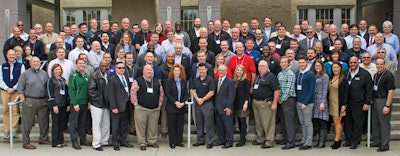
In January, the third NCS4 College Summit brought together safety and security professionals from across the country representing collegiate athletic programs large and small, with budgets to match. Attendees represented state and local law enforcement, emergency services, athletic departments and public safety departments, to name a few.
"You couldn't ask for a better makeup," says NCS4 director Lou Marciani. "We had the mix, and we had good input from solutions providers, and perfect facilitators that worked hard to prepare. You can tell the end result of the preparation."
Though only in its third year, the summit illuminated just how far the industry has come in such a short time — and how much more work needs to be done. Moderated discussions included gameday safety and security, crowd dynamics and management, risk assessment and emergency action planning, staff development and performance, the culture surrounding safety and security, and facility design and technology implementation.
SPECIAL THANKS TO THE 2016 ADVISORY COMMITTEEMike Bamberger, Emergency Manager, Oregon State University Mark Bodenschatz, Associate Athletic Director for Facilities and Operations, Penn State University Robert Carney, Associate Athletic Director/Facilities and Operations, Boise State University Mike Caruso, Associate Athletic Director for Events and Game Operations, Texas A&M University Sharon Cessna, Director of Championships, NCAA Evan Feinglass, Associate Director of Athletics/Facilities Management and Planning, University of Connecticut Nate Hayden, Game and Event Manager, Football Bowl Association John King, Director of Public Safety/Chief of Police, Boston College Keri Luchowski, Executive Director, North Coast Athletic Conference Dan Mara, Commissioner, Central Atlantic Collegiate Conference Drew Pittman, Assistant Athletic Director, Baylor University Joey Strum, Chief of Police, University of Louisiana at Lafayette Mark Wesley, Director of Emergency Management, Eastern Michigan University Alfred White, Senior Associate Commissioner, Conference USA |
CULTURE SHIFT
The tone of the summit pointed to an overall culture shift in the role of security in the gameday experience. Spectators at sporting events have by and large been receptive to the increased security precautions. "Guests have a level of expectation and are more aware of security," says Russ Simons, managing partner with Venue Solutions Group and one of the summit's facilitators. "The more we can show 'eyes-on,' the more we tell our guests someone is taking care of them, it makes them feel more comfortable."
Simons also illustrates another shift in the role of security — there is an increasing emphasis on the guest-service experience. As such, security teams are ever more cognizant of the impact of new policies and procedures, such as long waits at metal detectors or the implications of prohibiting patrons from bringing in bags.
Security professionals are taking on more visible roles as stakeholders in the gameday experience. "For the first time, safety and security have a legitimate seat at the table," says Auburn University associate athletic director of facilities and operations Jeff Steele, a fellow facilitator, noting that security is no longer an afterthought in facility design. By having a greater voice in the planning process, safety and security personnel can, if not build an ideal security infrastructure, set themselves up for improvements. "There's never enough money in construction projects," Steele says. "If you can't get cameras or card readers in, at least get the conduit. Pick the places and have it put in."
No discussion would be complete without mention of the obstacles standing in the way of achieving best practices. "Staffing was an area that came to the forefront," says facilitator Andy Burchfield, director of emergency management with the University of Michigan's division of public safety and security. "We're not just talking about it from a football operations standpoint; it's all the other types of events that are taking place — basketball, hockey, soccer, spring commencement."
Key considerations include knowing how to utilize your resources wisely, and holding the security team responsible for its decisions. "If you go with a high-threat package every single game, how do you respond when the higher-ups ask what you're doing differently?" Burchfield asks. "It's that tiered approach — having the appropriate staff in place and being able to scale up, and knowing what that requires in terms of resources."
What's next?
A great deal of emphasis was placed on what exactly a set of best practices means for the college athletics industry. No-reentry policies, for instance, were cited as a best practice, but in practice those policies varied greatly among attendees. "Does that mean nobody has reentry?" asks Simons. "Absolutely not. Does that mean the best practice is invalid? No. Knowing the difference between where you are and where the best practice is allows you to create a map to move toward where you want to be."
There will be changes to the best practices, Steele added. Not only will the potential risks to venues and events evolve, but the tools and technologies the industry uses to guard against them will, as well. "If you had told us years ago we would be using technology so extensively, most of us would have said, 'No way,' " says Steele.
Existing resources, such as cameras, access control systems and social media monitoring, will continue to advance and open up new opportunities for security personnel. New issues will arise, such as ticketing and credentialing via smart phone. And some new technologies may prove to be double-edged swords. "Drones can be really helpful in expanding safety and security," Steele says. "But how do you tell the differences between the good uses and the bad? The answers aren't going to come from the federal government. They're going to come from folks like us who have to manage it every day."
As this year's summit wrapped up, Marciani spoke of the tasks ahead — namely, compliance. Now that a set of best practices exists, what measureable impact are they having? "It's going to be put through an academically vetted practice to validate," Marciani says. "We get the chance each year to refine these best practices and implement these changes as time goes on. But that process is going to look a bit different next year."
This article originally appeared in the Spring 2016 issue of Gameday with the title "Pioneering safety and security best practices at the NCS4 Collegiate Summit"

































